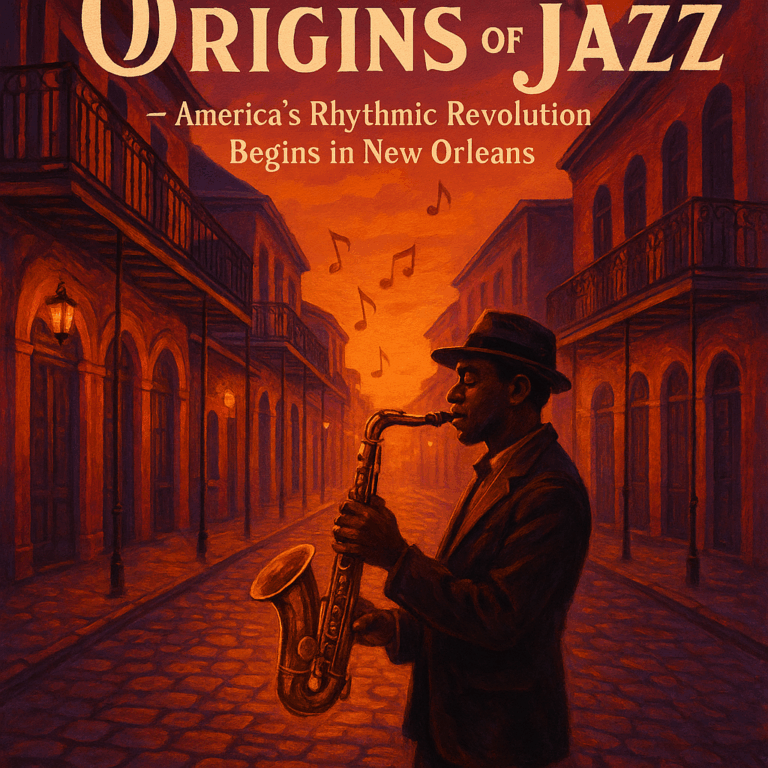The Soulful Genesis of Jazz: America’s Rhythmic Revolution
Jazz, a vibrant pillar of American music, bursts forth from the fertile cultural crossroads of early 20th-century New Orleans. This dazzling genre evolved from the intricate tapestry of African, Caribbean, and European musical traditions swirling in the city’s back alleys and lively dance halls. Rooted deeply in blues music and enriched by the syncopation of ragtime, jazz carried the heartbeat of a people who transformed hardship into a jubilant, transcendent sound. Its history isn’t just a timeline—it’s a living narrative of resilience, innovation, and unrelenting spirit.
As the flicker of gas lamps touched the humid air, jazz carved out spaces in speakeasies and street corners, proving to be both a rebellion and a celebration. It was the soundtrack of an era grappling with rapid social change—the Great Migration, racial tensions, and the search for identity. Jazz thrived on improvisation, a call-and-response energy that mirrored the conversational pulse of life itself. The syncopated rhythms stirred bodies and souls alike, making the genre an unparalleled expression of freedom and personal voice. It’s no exaggeration to say that jazz invented a new musical language, one that would ripple through every corner of American music.
What Defines Jazz: More Than Just Notes
Jazz defies capture by any single definition—it’s a dynamic, evolving conversation between musicians. At its core, jazz is an exquisite dance of rhythm and melody, where the blues scale often colors emotional expression, and swing rhythms ignite physical movement. Unlike many genres, jazz thrives on spontaneity; the magic lies in the moment of improvisation, when a saxophonist’s soulful wail or a pianist’s playful riff becomes a personal statement speaking directly to the listener’s heart.
This genre pulls threads from blues music’s melancholia and depth, layering them with complex harmonies and syncopated beats flowing like a river unbound. The typical jazz ensemble—trumpet, saxophone, piano, bass, and drums—forms a collective dialogue, a sonic community where each voice both stands out and blends seamlessly. The genre’s adaptive nature means it embraces styles as diverse as bebop’s frenetic pace, cool jazz’s understated sophistication, and avant-garde jazz’s boundless experimentation, continuously pushing musical and cultural boundaries.
Key Architects of the Jazz Horizon

To traverse the world of jazz is to encounter giants whose music transformed American music itself. Louis Armstrong, with his gravelly voice and impeccable trumpet flair, didn’t just shape jazz; he redefined its swagger and soul. Armstrong’s groundbreaking “West End Blues” (1928) was a soaring declaration of instrumental virtuosity and heartfelt storytelling that echoed across the world. His charisma made jazz accessible to many who had previously kept their distance from its complex rhythms.
The genius of Duke Ellington elevated jazz to new heights with his sophisticated compositions and orchestra leadership. Ellington’s ability to blend rich harmonies with intricate arrangements in pieces like “Mood Indigo” and “It Don’t Mean a Thing (If It Ain’t Got That Swing)” revealed jazz’s capacity for elegance and emotional depth. Ella Fitzgerald, whose voice soared effortlessly through the blues-drench and bebop eras, brought vocal improvisation to the forefront, turning songs into breathtaking narratives.
Charlie Parker, the bebop pioneer, introduced a frenetic, intellectual style of jazz that challenged listeners and musicians alike to embrace new harmonic landscapes. His compositions, including “Ornithology” and “Now’s the Time,” shattered conventions and inspired generations. On the West Coast, innovators like Miles Davis constantly redefined jazz’s boundaries; Davis’s album “Kind of Blue” (1959), a masterpiece of modal jazz, is often hailed as one of the greatest recordings in American music history, its haunting, minimalist beauty a magnet for soul seekers.
Timeless Anthems and Albums That Shaped the Soul
Jazz’s luminescent archives glow with timeless recordings that continue to inspire, educate, and move listeners. From the raucous, joy-filled sessions of New Orleans’ early days to the sophisticated frameworks of later jazz explorations, each album captures a unique facet of its evolution.
Thelonious Monk’s “Brilliant Corners” showcased the genius of unconventional melody and rhythm. Monk’s idiosyncratic piano style challenged the norms, his compositions full of quirky genius that both perplexed and delighted. John Coltrane’s “A Love Supreme” is an epic spiritual journey through saxophone meditations, a landmark recording that elevated jazz to a profound exploration of faith and transcendence.
The intersection of blues music and jazz is beautifully illustrated in the works of B.B. King and Ray Charles, whose soulful explorations gave rise to the electric energy of R&B music. Charles’s fearless merger of gospel, blues, and jazz idioms created a poetic style that informed the burgeoning soul genre. “What’d I Say” sparked a cultural awakening—one foot in jazz’s improvisational realm, the other firmly planted in the groove-centric world of R&B.
The Lasting Impact: Jazz as a Cultural Beacon
Jazz’s legacy is omnipresent, weaving through the very fabric of American music and culture. It’s not just a genre—it’s an ever-evolving expression of human emotion, ingenuity, and social commentary. By breaking musical rules and racial barriers, jazz paved the way for the acceptance and celebration of diverse voices in American music. Its influence pulses through hip-hop’s rhythmic complexity, the soulfulness of R&B music, and the broad contours of modern pop and funk.
Jazz festivals—from Newport to Montreux—continue to draw global audiences, proving the genre’s enduring appeal and its power to unite cultures. Educational programs worldwide teach jazz not just as a musical form but as an embodiment of freedom and creativity. The genre’s ethos of improvisation inspires artists in all disciplines, encouraging risk, dialogue, and authentic expression.
Jazz’s story is a tireless testament to the human spirit—born from adversity, nourished by community, and destined to inspire. It’s a genre that doesn’t just sound good; it feels good, shaking loose the shackles of convention and inviting us all to dance to the rhythm of possibility. The blues, jazz, and R&B music pulse as lifeblood of American music, each genre feeding the other’s fire, and together they form a magnificent legacy of rhythm, soul, and storytelling that continues to echo through generations.